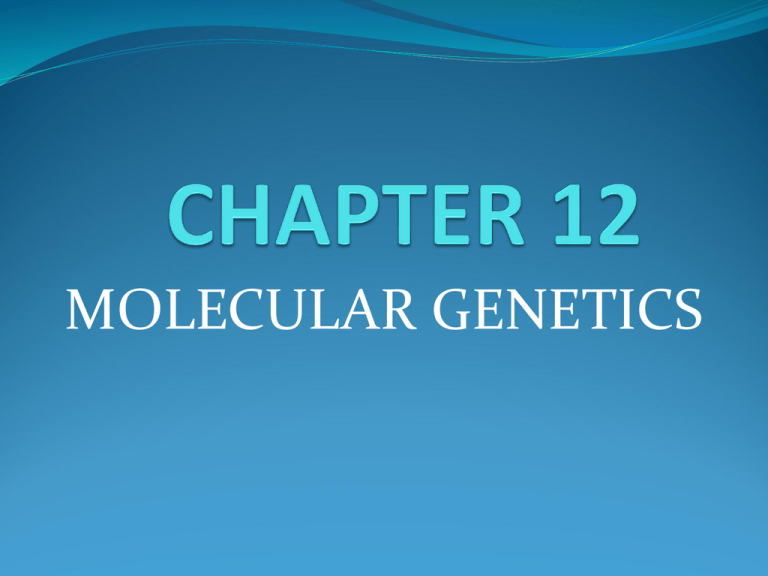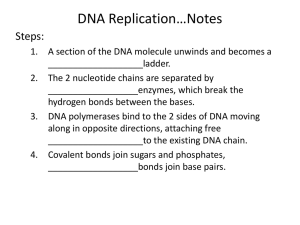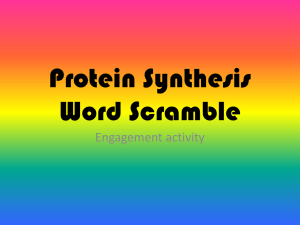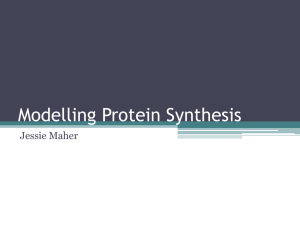
MOLECULAR GENETICS
Ch. 12.1 – DNA: The Genetic Material
You will be doing this section in small groups.
Each group will read Section 12.1.
You will divide up the section so that everyone is reading equal
amounts.
As you read your section you will put down some important
information, such as:
Year for the discovery
Person(s) who did the discovery
What was discovered &/or how they made discovery
Next, you will put together all of your information into a
timeline for the discoveries
Ch. 12.1 – DNA – THE GENETIC MATERIAL
Key points from Section 1
Nucleotides
Nucleotides are subunits of the macromolecule group of nucleic
acid
Composed of 5 carbon sugar, a phosphate group, and a nitrogenous
base
Nucleic acid
2 different types:
DNA
Nucleotide is composed of deoxyribose sugar, a phosphate
group and a nitrogenous base
Nitrogenous bases are:
Adenine (A), Guanine (G), Cytosine (C), or Thymine (T)
RNA
Nucleotide is composed of ribose sugar, a phosphate group
and a nitrogenous base
Nitrogenous bases are:
Adenine (A), Guanine (G), Cytosine (C), or Uracil (U)
Section 12.1 Key Points Continued
Purines are double ringed bases such as:
Guanine and Adenine
Pyrimidine are single ringed bases such as:
Thymine, cytosine, and uracil
Chargaff’s Rule:
C=G
T=A
Watson (IU graduate) & Crick built the double helix
model for DNA
Unique feature of the DNA molecule is the direction
the 2 strands run which is opposite of each other or
antiparallel.
Section 12.1 Key Points Continued
Chromosome Structure
A human chromosome length ranges from 51 million
to 245 million base pairs long.
A DNA strand that is 140 million nucleotides long
would measure approximately 5 cm. long (2 in.)
To fit all of this into the nucleus of the cell the DNA
tightly coils around a beadlike protein called a histone
The histone & the DNA together creates a
nucleosome.
The nucleosomes group together into chromatin
fibers, which supercoil to create the DNA structure
called a chromosome.
biology.kenyon.edu
SECTION 12.2 – REPLICATION OF DNA
MAIN IDEA – DNA replicates by making a strand
that is complementary to each original strand.
REVIEW:
What nitrogen bases pair together?
What is contained in the nucleotide for DNA?
What nitrogen bases would you find in DNA?
What is contained in the nucleotide for RNA?
What bases would you find in RNA?
SEMICONSERVATIVE REPLICATION
Semiconservative replication is where parental
strands of DNA separate and serve as the template to
produce DNA molecules that have one strand of
parental DNA and one strand of new DNA.
csls-text2.c.u-tokyo.ac.jp
Where does DNA replication take place?
During what phase does DNA replication take place?
Will DNA replication take place in mitosis, meiosis, or both?
UNWINDING AND BASE PAIRING
DNA helicase, an enzyme, will unwinding & unzip the
double helix leaving single strands of DNA.
DNA polymerase, an enzyme, helps in adding the correct
nucleotides to the new DNA strand.
Adenine (A) pairs with thymine (T)
Guanine (G) pairs with cytosine (C)
Base pairing:
Template:
DNA copy:
A T C C A G G T G
Produces identical copies to the original double
stranded DNA
DNA replication will begin at many places along the
chromosome
SECTION 12.3 – DNA, RNA, AND PROTEIN
MAIN IDEA – DNA codes for RNA, which guides
protein synthesis.
QUESTION: How does DNA replication relate to
mitosis?
How does DNA replication relate to meiosis?
How does DNA replication relate to
reproduction?
CENTRAL DOGMA
Remember – proteins function as structural
building blocks for the cells and as
enzymes.
Central Dogma of biology: DNA codes for
RNA, which controls the synthesis of
proteins.
DNA → RNA → PROTEIN
RNA is a nucleic acid that is similar to DNA,
except:
RNA contains the sugar ribose, uracil
replaces thymine, and is single stranded.
TRANSCRIPTION
Transcription is the step in the central dogma – synthesis
of the mRNA from the DNA
Transcription = DNA → RNA
Transfers the DNA code to mRNA in the nucleus.
mRNA takes the code into the cytoplasm for protein
synthesis
To create mRNA the DNA is unzipped in the nucleus and
RNA polymerase binds to a specific section and creates
the mRNA
The strand of DNA that is read by the RNA
polymerase is called the template strand.
The strand of DNA not read by is called the
nontemplate strand.
Uracil is used instead of thymine in mRNA
New mRNA strand leaves the nucleus through the
nuclear pores into the cytoplasm
CENTRAL DOGMA CONTINUED
3 main types of RNA:
Messenger RNA (mRNA)
Long strands of RNA nucleotides that are formed
complementary to one strand of DNA
Leave the nucleus and go to the ribosomes to
direct the synthesis of a specific protein
Ribosomal RNA (rRNA)
Type of RNA that combine with proteins to form
ribosomes in the cytoplasm
Transfer RNA (tRNA)
Small segments of RNA nucleotides that
transport amino acids to the ribosome.
faculty.southwest.tn.edu
. legacy.hopkinsville.edu
RNA PROCESSING
Scientists noticed that mRNA was
shorter than the coding region of DNA
Found that the DNA is interrupted by
sequences, called INTRONS, that are
not in the final mRNA
Coding sequences that remain to make
up the mRNA are called EXONS.
Before mRNA leaves the nucleus the
INTRONS are removed
TRANSCRIPION CONTINUED
Remember: Base pairs in RNA
Cytosine Guanine
GuanineCytosine
• Adenine Uracil
Uracil Adenine
• Thymine (from DNA) Adenine
• DNA Strand: A T G C T A A G C
RNA Strand:
________
•
THE CODE
There are 20 amino acids that are used to
make proteins.
DNA code is read as a 3 base code.
In DNA or mRNA the 3 base code is called
a CODON
The codon that will start the reading of
the mRNA is the codon AUG, which codes
for the amino acid methionine
GENETIC CODE:
emc.maricopa.edu
CIRCLE GENETIC CODE:
krishnascience.info
The Genetic Code
Proteins are made by joining amino
acids into long chains called
polypeptides
amino acids are like puzzle pieces
Proteins would be like the whole
puzzle
TRANSLATION
Translation = RNA → protein
Once the mRNA is made and the introns are removed
and exons are left mRNA leaves the nucleus and goes
and attaches to a ribosome in the cytoplasm
This is where the mRNA is read and translated to
make a protein through a process called translation.
Translation involves:
tRNA that acts as the interpreters of the mRNA codon
sequence.
tRNA has a cloverleaf shape that has a 3 base coding
sequence called the anticodon.
Anticodons are complementary to a codon on the
mRNA.
ROLE OF THE RIBOSOME
Ribosomes consists of 2 subunits.
When mRNA leaves the nucleus the 2
subunits of the ribosome come together and
attach to the mRNA.
Now the tRNA will bring in the correct
amino acid and attach to the mRNA.
This continues until a stop codon is reached
and it is the end of the protein synthesis.
Protein is now released.
TRANSLATION:
ajinomoto-eurolysine.com
SECTION 12.4 – GENE REGULATION
AND MUTATION
MAIN IDEA – Gene mutation is
regulated by the cell, and mutations
can affect this expression.
QUESTION: What words and images
come to mind when you hear the words
mutation or mutant?
HOX GENES
Gene regulation is crucial during
development.
Eukaryotes develop from a single cell called a
zygote.
Zygote produces all the different kinds of cells
needs by the organism by mitosis.
Hox genes helps control how the body of an
organism develops.
Mutations in the Hox genes can cause a fruit
fly to develop a leg where its antennae
should be.
HOX GENE MUTATION:
palaeos.com
MUTATIONS
Mutation is a permanent change in a cell’s DNA.
Types of gene mutations:
Point mutation is a chemical change in one base pair
and could cause a genetic disorder.
Types of point mutations:
Substitution (missense) – one base is exchanged
for another
EX: C is replaced with G (now codes for the
wrong amino acid)
Substitution (nonsense) – changes the codon for
an amino acid to a stop codon causing translation
to end early resulting in a protein that cannot
function normally.
MUTATIONS – CONTINUED
Types of gene mutations continued:
Frameshift: Insertion – adds a nucleotide to the
DNA sequence shifting the reading frame
EX: original strand: A C C G G C C A A
amino acids: _________________________________
mutated strand:A C C C G G C C A A
amino acids: _________________________________
Frameshift: Deletion – deletes a nucleotide from
the DNA sequence shifting the reading frame
EX: original strnad:
ACCGGCCAA
mutated strand: A C G G C C A A
CHROMOSOMAL MUTATIONS
Deletions
Part of chromosome is deleted/gone completely
Original: A B C D Deleted: A C D
Duplications
Part of chromosome is duplicated/repeated
Original: A B C D Duplicated: A A B C D
Inversions
Part of code is read in a different direction (reverses the
directions of the parts of the chromosome)
Original: A B C D, Inverted: A C D B
Translocations
Entire sections of chromosome are shifted (when part of one
chromosome breaks off and attaches itself to another
chromosome)
http://staff.tuhsd.k12.az.us/gfoster/standard/bmut.htm
CAUSES OF MUTATIONS:
Some mutations, like point
mutations, occur spontaneously.
Cells proofread so it happens
rarely
Mutagens are some types of
chemicals and/or radiation
BODY CELL VS. SEX CELL MUTATION
Body cell:
Mutation in a body cell (somatic cell) is in that one
cell and the future daughter cells that this cell makes.
If these mutations do not cause problems for the cell
it is called a neutral mutation.
If these mutation cause problems in the cell the cell
could become cancerous or the cell may die.
These mutations are not passed down to offspring
Sex cell:
If the mutations occurs in the sex cells it will be
passed down to the offspring and will be present in
every cell of the offspring.
The mutation may or may not affect the offspring.










